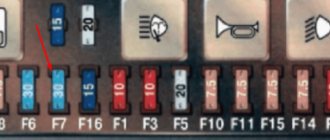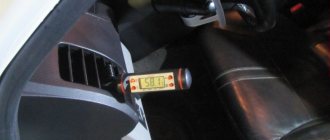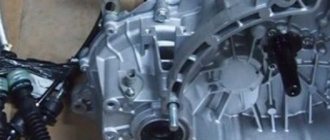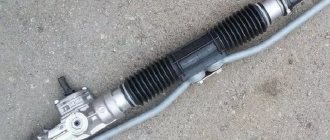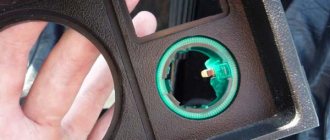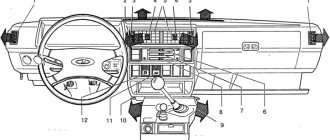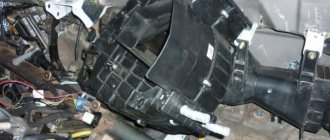What is a heater radiator?
The heater radiator belongs to the cooling system. It looks like a mini version of the main engine cooling radiator and is essentially a small unit that consists of small tubes installed in parallel, connected by a series of cross plates (or fins) designed to dissipate heat. This radiator ensures the operation of the interior heater and the vehicle's glass heating system.
FAQ
How does a car heater work?
The stove fan draws in air from outside or inside the cabin and drives it through the honeycomb of the stove radiator, where it heats up. Then the heated air enters the cabin through the air ducts. The heating of the air itself occurs when hot coolant from the engine cooling system circulates through the radiator. We can say that the principle of operation of the stove is similar to the operation of conventional home radiators, only the distribution of air is regulated by a fan.
On what principle does a heater radiator work?
Coolant circulates through small tubes in the heater core, entering through one hose and leaving through another. The radiator, by dissipating the heat of the fluid passing through it, provides heating to the cabin, preventing passengers from freezing on a cold winter morning. In addition, the heater radiator is responsible for the operation of the glass heating system. It is connected to the air conditioning system, organized according to almost the same principle.
How to understand that the heater radiator is faulty?
Below are five main signs that indicate this particular problem. It is quite simple to understand that the heater radiator has malfunctioned or is out of order. But replacing this radiator is not an easy task.
Important information! Only one or a few signs of a heater core malfunction may appear at a time, but there are situations in which these signs appear all at once. This mainly depends on the age and condition of the car at the time the radiator failed.
Foggy windows
The very first sign of a malfunctioning heater core is sudden fogging of the inner surface of the windows without any obvious reason. Fogging of the windows does not mean slight fogging of the edge of the windshield, but the abundant formation of warm condensation over the entire area of all the windows of the car.
It is possible that while the car was moving, that is, after the engine had warmed up sufficiently, damage to the heater radiator occurred. As a result, heated coolant entered the cabin and caused condensation to form. The thing is that until this moment the liquid circulated in a warm temperature-controlled cooling system, and once in the cabin with a lower air temperature, it began to turn into steam.
Smell of melon
Regardless of whether your car's windows are fogged up due to damage to the heater core, the most unmistakable sign of a leaking heater is the appearance of a sweet, fruity smell in the cabin. This is what coolant smells like, so this smell definitely indicates it is leaking.
If you smell that pleasant smell from the outside of your car, look underneath to see how much coolant has leaked onto the ground.
Excessive coolant consumption by car
If your vehicle (it could be a car, truck, or minivan) suddenly develops a voracious appetite for coolant, and you don't understand why this happened, check to see if the heater core is damaged. If it was not possible to quickly detect the leak, it is likely that the liquid leaked into the cabin from a cold system, so the windows did not fog up, but a puddle formed. The first thing you should check is the floor in front of the front passenger seat. If the floor is wet and these are not wet footprints from shoes or a bag, then the whole issue is a faulty heater core.
Brr! It's cold in the cabin!
Low air temperature in the car interior is not always a sign of a malfunction of the heater radiator. The fan motor or other heater component may have failed (which is a good thing, since replacing some components can be much cheaper than replacing the radiator). But if the lack of heat in the cabin is accompanied by other signs, this indicates a problem with the heater core.
If there is a hole or puncture in the heater core, warm air may escape too quickly before reaching the other end of the heater ducts. Warm, barely warm, or even completely cold air may enter the cabin, depending on the degree of damage.
The engine is hot but the interior is cold
If you notice that the engine has overheated or continues to overheat, you should definitely check the condition of the heater core. But keep in mind that many other factors can cause engine overheating. If the radiator has stopped supplying heat to the vehicle interior, but the engine is still warm, find out if there is a coolant leak at any other point or if other problems have arisen.
Overheating of the engine is extremely dangerous, since it also heats up other critical components of the car, as a result of which they begin to wear out quickly and fail in record time.
If the engine begins to overheat, you should find out the cause as soon as possible and eliminate the malfunction.
If the temperature gauge arrow reaches the red zone, stop using the car and call a tow truck to take the car to a repair shop. Of course, you can ignore these recommendations, but believe me, in this case you will learn a good lesson.
TOP 10 best stove radiators of 2021
And finally, about the main thing. This is what our drivers and the European press say about heater radiator manufacturers. We did not sort them by price, but the rating presents only the best companies on the Ukrainian market.
VALEO
Clutch kits, windshield wiper blades, brake pads - and this is not all that the company has been doing since 1923. The products of the French company are supplied to the assembly lines of Audi, Daewoo, Fiat, Alfa Romeo, Renault, Volkswagen, and Hyundai. Including stove radiators.
It is distinguished by precise dimensions, excellent quality, and thanks to branches in 32 countries, it is difficult to find a car model that does not have a heater radiator from VALEO.
Interesting on the topic: 2021 Mitsubishi ASX review. I cried, and the sakura blossoms again
BEHR Hella Service
The BEHR Hella Service concern was formed in 2005 as a result of the merger of companies of the same name. The German company BEHR has been producing radiators since the beginning of the twentieth century, and since 1930 it has been supplying radiators to the Ford assembly line in the USA.
Today, conveyors of Mercedes, Subaru, BMW, and Volkswagen are equipped with the company’s radiators. They are considered one of the most reliable in Europe, unless you fall for a fake. There are a lot of them in Ukraine lately.
SAT
Despite its Chinese roots, the company specializes in spare parts for Japanese and American cars. At the same time, stove radiators are assembled not only in China, but also in many countries in Asia and Europe. The quality of the radiators is not bad, the average lifespan is about three years.
The big plus is that there are practically no fakes and the quality is stable. Also, many will be pleased with the price, especially for cars in the low-cost segment. The brand is constantly developing and covers the model range of the most popular brands in Ukraine.
Stellox
Since 2005, the company has been supplying a wide variety of spare parts from a variety of manufacturers. This is a packaging company. Therefore, the radiator of the Stellox stove in the original box can be from any manufacturer. And of any quality. There is no guarantee that it will fit in size, although reviews indicate an 80% success rate.
The big plus is the low price, the big minus is the instability of quality and size.
Nissens
Danish Nissens radiators are one of the best stove radiators on the European market. It’s bad that there are a lot of fakes in Ukraine. True, you can most often distinguish them by their cheap packaging and homemade printing. If the radiator is original, it will last a long time and without problems.
In some cases, the resource exceeded far more than 100 thousand km. The only negative is the high price.
Polcar
Some of the best stove radiators in the lowest price niche. This means that the probability of buying a radiator with an exact match of geometry is 50/50. If you want to take a risk and save money, this is a completely suitable option. Basically, the quality of Polish Polcar radiators is above average, and for their price they will perform tolerably well.
Interesting on the topic: New 2021 Toyota RAV4 Adventure: all the pros and cons
NRF
Dutch NRF stove radiators are in stable demand. High quality and long service life, careful assembly and packaging, very few negative reviews. Mainly because of counterfeits, but over the past year they have become fewer. Large assortment, average price, good reviews.
FEBI
Theoretically, the company is German, but the stove radiators can be made anywhere. This is mainly a packer, owned by the multi-brand concern Ferdinand Bilstein GmbH. Radiators are expensive, but if you get a good manufacturer, they will last a long time. They usually approach the selection of suppliers with feeling.
Denso
The Denso brand operates more than 70 companies around the world. The closer to Europe the stove radiator was produced, the higher the quality guarantee. The middle price segment, a well-known company, still inspires confidence in itself, since it began as a division of Toyota. Supplies radiators to many Japanese, Korean and Chinese conveyors.
Hans Pries (Topran)
A company that is not particularly well-known in Ukraine, theoretically a German brand, produces everything, but the stove radiators mainly come from China. The low price in this case does not mean lousy quality. For the most part, reviews from our drivers and mechanics from Europe are good.
Causes of heater malfunction in a car: how to diagnose and fix it
Issues discussed in the material:
The stove, ventilation system and car heating provide quick heating of the interior and a comfortable temperature for the driver and passengers. During the warm season, the heater is rarely used, so the main problems in its operation are revealed only after the weather gets colder. The reasons for a malfunction of the stove in a car can be different. There are mechanical breakdowns, problems with electronics or electrical equipment, as a result of which the supply of warm air to the car interior is stopped. In this article we will look at the most common breakdowns and methods for eliminating them.
The principle of operation and the main reasons for the malfunction of the stove in a car
Before moving on to considering the causes of stove malfunctions in cars, it is worth familiarizing yourself with the operating principle of automobile heating systems. To ensure a comfortable temperature in the car interior, it is necessary that all elements and components responsible for supplying warm air are in good condition. The interior heater in a car has a simple design.
The best stove radiator. What should he be like?
“Cheap” is the wrong answer. High-quality material cannot be cheap, and inexpensive crafts from “young developing brands,” mainly from China, cannot work humanely.
Normal operation of the heater radiator for every car owner, without exception, means:
- High heat transfer properties. The temperature in the cabin directly depends on how quickly and without loss the radiator releases the heat from the antifreeze.
- Thermal inertia . That is, how quickly the radiator warms up and cools down quickly. Note that these are two mutually exclusive factors. But more on that later.
- The ability of the radiator to resist corrosion .
- Mechanical strength .
- A design that implies high efficiency of the radiator . This includes a lot of nuances - the diameter of the tubes, the method of soldering cans and honeycombs, the geometry of the honeycombs, the number of tubes and their configuration, and many other factors.
- Tightness . Does anyone need a heater that is always leaking under the passenger's feet?
- Full compliance with the geometric dimensions, seats and methods of connection to the cooling system of each specific model and modification, down to the millimeter.
Ways to eliminate the causes of a malfunctioning stove in a car
Depressurization of the cooling system is considered the most common malfunction, which often leads to complex repairs that require large financial costs. Detecting an antifreeze leak is not at all difficult. First of all, it manifests itself in a decrease in the liquid level in the expansion tank.
If such a malfunction is detected, you should use an inspection hole or overpass to thoroughly check all components and elements of the cooling system for leaks. Leakage often occurs due to damage to the radiator, wear of pipes and other parts.
The air that enters the cooling system leads to malfunctions of the stove. In most cases, a faulty radiator and damaged pipes must be replaced.
In car dealerships you can find special additives that supposedly can eliminate leaks in the car’s cooling system. It should be noted that the use of such products can lead to clogging of thin radiator tubes.
Quite often there are car heater malfunctions caused by the fact that two different antifreezes were poured into the cooling system, which are incompatible with each other. Liquids that differ in composition, when interacting, coagulate and form an adhesive composition that clogs the channels of the radiator and other elements of the cooling system.
Eliminating such a malfunction is a rather complex process. To flush the system, special equipment and special compounds are required. Caustic soda works most effectively. After using the active substances, the system is washed with water. To clean the heater radiator from internal deposits, it is necessary to disconnect its external pipes. If flushing the system fails, the problem can only be eliminated by replacement.
If the cause of the stove malfunction is the accumulation of dirt on the radiator of the cooling system, it is necessary to disassemble the unit. After this, the radiator should be blown out with a stream of compressed air. The same method can be used to detect heavy contamination on the surface of the cabin filter. In winter, malfunctions of the stove may occur due to snow getting into the car's air intake.
We recommend
Independent search for the causes of a malfunction of the stove in a car or contacting a service station
The technology for troubleshooting the stove is selected depending on the cause of the breakdown and the make of the car. If a coolant leak or an air lock is detected, you can carry out the repair yourself. At the same time, if the cause of the breakdown is damage to the radiator or a malfunction of the control automation, then you cannot do without the help of professionals. Unqualified maintenance of the cooling system can lead to additional malfunctions and significantly increased repair costs.
Experts recommend performing an initial inspection of the machine to identify the causes of the stove malfunction (check the antifreeze level, fan operation, presence of air in the system or leaks, etc.). If such a check does not allow you to find out why warm air does not flow into the car interior, you need to contact car service specialists who will carry out professional diagnostics of the stove’s operation and eliminate any identified breakdowns.
Source
Purpose and design of the stove radiator
The heater radiator is designed to create a comfortable microclimate in the car interior
Design and location of the stove radiator
The vehicle interior heating system usually consists of a radiator connected to the engine cooling system, a motor with an impeller (fan), air ducts and a number of control and regulating elements. Space under the front panel is usually allocated for installing a radiator.
The stove works as follows. Hot antifreeze from the engine cooling system enters the heater radiator and heats it. The fan blows through the radiator honeycombs and supplies warm air into the cabin through the air duct system. By changing the fan rotation speed and the position of the dampers, you can regulate the temperature in the cabin.
The operation of the interior heater is based on the circulation of coolant through the heater radiator and heat extraction through a fan
Types of stove radiators
Stove radiators are classified according to various criteria. According to the material from which they are made, they are distinguished:
Despite the high heat transfer and the possibility of repair, copper radiators are rarely used. This is due to their high cost relative to aluminum products. Aluminum radiators, in addition to their low price, have less weight. However, when a leak occurs, such radiators most often have to be replaced with new ones.
Operating principle of the heater
To protect the engine from overheating, the car's cooling system has a main radiator. When fuel is burned, thermal energy is converted into mechanical energy and is produced in such large quantities that it would be enough to heat two average private houses. The radiator consists of metal tubes and plates within which coolant circulates. It is placed under the hood so as to allow as much air as possible to pass through when moving, and thanks to its design, the area of contact with air flows is significantly increased. Coolant takes excess heat from the engine and transfers it to the air.
Even at idle speed, the engine gets so hot that it needs to be cooled. If the car is not moving anywhere, then the fan located next to the radiator is turned on. Antifreeze flows are regulated so that the engine does not cool down or overheat. Normal temperature fluctuations of the liquid are 80-95 C.
The stove also takes away excess heat from fuel combustion; it is included in the small circuit of the cooling system, and the main radiator is included in the large one. In winter, when starting the engine, the liquid moves directly through the water jacket to the stove to warm the interior as quickly as possible. Only after warming up, excess heat is released into the atmosphere.
The main part of the interior heating system is the stove radiator, also consisting of metal tubes. Antifreeze is supplied to it through the pipes from the engine water jacket and discharged back in a cooled state. The stove is equipped with a fan and air vent tubes through which warm air is pumped into the interior. The heat supply is regulated by control devices or climate control. To reduce or increase the temperature, the antifreeze flow or fan speed is changed.
Signs of a malfunctioning heater radiator
During the operation of a car with a radiator, various problems may arise, as a result of which the heating of the interior usually stops. The most common faults are:
Air lock in the cooling system
To identify the appearance of an air lock, turn on the heater on a warm engine. If cold air enters the cabin, then most likely the problem is the airing of the system. Due to the accumulation of air in certain areas of the cooling system, antifreeze cannot circulate normally and leads to disruption of the normal operation of the stove. Air locks can cause the engine to overheat and seize.
An air lock can also be determined by a rapid increase in the temperature of the power unit due to disruption or cessation of coolant circulation. If such a malfunction is detected, it should be corrected immediately.
Air may enter the cooling system for the following reasons:
Due to damage to the cylinder head gasket, an air lock may form in the cooling system.
There are three ways to remove an air lock.
On domestically produced cars, the air lock in the cooling system can be removed through the expansion tank
Clogged heater radiator channels
Clogged radiator channels can also cause the stove to heat the air poorly. Since the coolant does not pass through the radiator in this case, the inlet pipe will be hot and the outlet pipe will be cold. Clogged channels can occur in the following situations:
If it is not possible to replace the radiator with a new one, you can try flushing it. For this purpose, special chemically active compounds are sold in car dealerships. In addition, you can use a solution of citric acid (400 g of acid per 4 liters of water).
The heater can become clogged not only from the inside, but also from the outside.
Radiator leak
The appearance of a leak is usually associated with mechanical damage to the radiator or with the use of low-quality antifreeze. Finding the problem is not difficult. Most car owners in this case immediately replace the radiator with a new one, and the feasibility of repair is determined by the extent of the damage.
Leaks in the radiator are usually associated with mechanical damage
Radiator honeycomb contamination
During operation, the radiator honeycombs may become clogged with debris, dust, dirt, etc. In this case, the stove will work less efficiently. To fully clean the radiator, it will need to be dismantled. Cleaning can be done in two ways:
In the first case, you can use a high-pressure washer with a vario attachment. When using the cutter attachment, the radiator honeycombs may bend. The stream of water should be directed from a distance of 30–50 cm at a right angle. You can use compressed air instead of water, but it will be less effective.
Clogged radiator channels are the main reason for reduced heat transfer.
Our Lanos. Heater radiator, repair and flushing without removal
As with every car, the stove on Lanos can from time to time not heat well and blow cold air. Replacing the heater core is a last resort, and it is only used in the event of a leak or mechanical damage. In almost all cases, a clogged heater radiator can be washed and brought back to life without removing it from the car or disassembling the interior. We will find out how to flush the heater radiator on Lanos, how to fix other heater breakdowns without disassembling it right now.
Heater malfunctions of Daewoo Lanos
The radiator of the Daewoo Lanos stove suffers not only from scale and sediment. The efficiency of the heater often sags due to the displacement of the radiator, as well as due to leaks in the air duct and the heater body. If the heater blows cold air at normal engine temperature, you must carefully check each element of the cooling system:
- Thermostat . Depending on the thermostat model, the engine warm-up time may vary. We have already figured out how to replace the thermostat on Lanos and in what cases it is advisable to install a thermal valve with an operating temperature of 95 degrees.
- Water pump. In the event that the pump does not create the required pressure in the system, the circulation of antifreeze is disrupted, which also affects the operation of the heater.
- Stove radiator. On Lanos, as on some other models, the heater radiator is installed at an angle of about 45 degrees. Sometimes this causes the system to become airy if the antifreeze is not replaced correctly. In addition, it is not uncommon for the radiator to move downwards. In these cases, the efficiency of the heater suffers greatly. In addition, the stove radiator can be clogged with deposits, scale and decay products of low-quality antifreeze. We replace the heater radiator only as a last resort. How to change and select is described in detail here.
- Airlock. The stove will not heat if an air lock has formed in the cooling system for various reasons. We figured out how to deal with it here.
- Failure of the heater control unit . In this case, the electric motor of the stove may either not work at all, or work only in one mode.
- Heater electric motor . If the stove motor does not turn on, you will have to disassemble the entire structure, unless the fuse is the problem. It is located in the mounting block under the hood, rated 30 A, designated Ef 3. It also protects the power supply circuit of the starter and ignition switch.
- Cabin filter. The stove will heat poorly if the cabin filter is clogged. In those Lanos that do not have a cabin filter by design, the air supply pipe may simply become clogged. We discussed how to check and replace the cabin filter here.
- Any other violation of the circulation of antifreeze in the cooling system.
The color of antifreeze after flushing the radiator of a stove with a mileage of 180 thousand
In addition, the use of low quality coolant naturally affects the operation of the heater. As a rule, cheap liquids like the legendary “antifreeze” kill the cooling system quite quickly, especially in winter. Plaque in the cooling system and clogging of the heater radiator on Lanos can also be caused by mixing antifreezes of incompatible composition, as we have repeatedly seen. The cause of a clogged stove radiator could easily be another magic composition for eliminating a leak in the cooling system.
How to check the Lanos heater radiator
If we are confident that the remaining components and systems of the heater and cooling system are working as expected, we have checked them and found no faults, then the heater radiator comes under our sights as the only target in the fight against cold in the cabin. The main signs of a clogged stove radiator:
- Regardless of the temperature of the antifreeze, the stove blows cold air.
- The inlet pipe of the heater remains hot, although the outlet is cold at normal engine temperature.
- An oily coating on the inner surface of the windshield and a characteristic sweetish smell in the cabin when the heater is on indicate antifreeze is leaking onto the surface of the radiator. This can also happen for the reason that the liquid is simply squeezed out from under the pipes due to clogged stove tubes.
- The heater blows cold air on the passenger side and hot air on the driver's side.
Actually, it is already clear that there is a problem with the radiator if it is the last one left in the chain of elements of the heating system. But the heater radiator gets clogged for simple reasons. Firstly, this is the use of low-quality, cheap, uncertified antifreeze.
Heater radiator repair
If the radiator is faulty, it needs to be repaired, cleaned or replaced. The last option is the simplest, but also the most expensive. However, quite often you can restore the radiator yourself.
Soldering an aluminum stove radiator
Unlike copper, aluminum radiators are difficult to solder. An oxide film forms on the surface of aluminum, protecting the metal from corrosion, chemical and temperature influences. This film can be removed by mechanical surface treatment and the use of special means.
Before repairs, the heater radiator is removed from the car, after draining the antifreeze. It is then washed with running water and dried. If the location of the damage has already been identified, repairs begin. If the exact location of the damage is unknown, it is determined using a compressor and a container of water. All holes in the heat exchanger, except the thinnest one, are closed with plugs. The radiator is immersed in water, filling it through the remaining hole with air from the compressor. The location of the damage is easily determined by the appearance of bubbles.
To solder the radiator you will need a powerful soldering iron.
To solder the radiator you will need:
Soldering is carried out as follows:
When soldering a radiator, solder is applied to the damaged area in an even layer
Video: soldering the radiator
Cold welding and other repair methods
Radiator cracks can be repaired using cold welding. To do this, separate a piece of the substance, knead it in your hand and apply it to the damaged area. Once the weld has completely dried and hardened, the leak will disappear. In addition to cold welding, various liquid or powder sealants are offered on the market to eliminate internal mechanical damage to the radiator. Previously, car enthusiasts used mustard powder for this purpose, pouring it inside the heat exchanger. A good option for restoring the tightness of the radiator is argon welding.
Epoxy glue can be used to seal cracks at the base of the tubes. The best results are achieved by adding a filler such as aluminum powder to the glue. After preparing the damaged area, an adhesive composition is applied to it, and to increase the rigidity of the joint, several layers of fiberglass soaked in glue are wound. After a day, the radiator can be installed in place.
Cleaning a clogged stove radiator without dismantling
If the heater radiator is clogged, you can try to clean it. Dismantling it is usually a rather complicated procedure. However, it is possible to flush the radiator without dismantling it.
To flush a copper or brass stove radiator you will need:
The process itself is performed as follows:
To flush the radiator, you need to remove the outlet and inlet pipes.
When flushing, hoses connected to the pump are placed on the radiator tubes.
To flush the radiator, you can use Domestos, Krot or similar products
Based on the condition of the liquid after washing, you can evaluate how effective the procedure was.
After flushing the radiator, the inner surface of the tubes becomes clean
It is not recommended to use alkaline solutions to flush an aluminum radiator. Alkali can react chemically with aluminum and damage the walls of the radiator. In this case, use a solution of citric acid in warm water (100 g of acid per 1 liter of water). The procedure itself is similar to flushing copper radiators. The efficiency of the process can be increased by circulating detergents using an electric pump. For final rinsing, it is advisable to use distilled water.
Washing efficiency can be increased by circulating detergent using an electric pump
One of the old-fashioned methods of flushing the cooling system is to use serum. The sequence of actions does not change. Some car enthusiasts use Coca-Cola to flush the heater radiator. However, this drink contains a large amount of sugar, which can start the caramelization process and make things very difficult.
Video: flushing the radiator without dismantling
Radiator flushing with dismantling
Sometimes flushing the radiator directly on the car does not give the desired result, and the heater continues to work poorly. In this case, you will need to remove the heat exchanger and clean it better. The dismantling algorithm is individual for each car model and, as a rule, is quite complicated. The same detergents and cleaning products are used. If after all the procedures the quality of interior heating has not improved, most likely you will need to replace the heater radiator with a new one.
The dismantled stove radiator can be cleaned and washed more efficiently
Thus, there are many ways to restore the functionality of a stove radiator without dismantling it. Most of them are quite simple. Step-by-step instructions and advice from professionals will allow you to repair a radiator with minimal investment of time and money.
Source
Aluminum or copper? Which stove radiator is better?
In principle, even a non-specialist in cooling systems can easily distinguish a copper radiator from an aluminum one. More than a dozen advisers, analysts and experts of various ranks have lost their lives on this front.
Today, manufacturers have made the choice easier, since copper radiators are being replaced from the market by aluminum ones.
Why is a copper heater core better? Or worse?
Copper is a very unique and multifaceted material. And by the way, dear. However, it has a lot of useful properties for us.
- A copper radiator can easily be repaired ; copper can be soldered perfectly without any special tools or dancing with a tambourine. It turns out that it is not so expensive if its service life is longer by default.
- The copper heat exchanger has high thermal inertia . It cools down very slowly. This means that after turning off the engine, we will still be able to extract heat from it for some time. True, it heats up longer than aluminum alloys.
- Copper is not as brittle as aluminum-based alloys. The elastic pipe is not so easy to break due to negligence. And for the same reason, there is less chance of defrosting a copper radiator.
Not everything is as simple as one of the general experts says. The range of copper radiators is much more modest than aluminum ones, since they are more expensive to manufacture.
And since automakers are completely switching to using disposable spare parts, they can’t afford to spend extra money on an eternal radiator.
The best stove radiator is made of aluminum. Or copper?
Aluminum stove radiators cost almost half the price. For reasons that we have already announced. But this does not mean at all that it is scrap metal. Chemists and engineers are constantly working on the composition of new aluminum-based alloys, improving their quality.
Interesting on the topic: Review of Volkswagen Passat 2021. Make way for the King!
Leading radiator manufacturers are naturally taking advantage of these latest advances, offering the market increasingly durable and efficient heat exchangers with a good range of benefits:
- Price . A good heater radiator won't cost a penny. You will have to pay up to 700-900 hryvnia for it, but it’s worth it. Depends on the specific car model. Of course, there’s probably not much point in spending that kind of money on a twenty-year-old VAZ 2110.
- Aluminum warms up quickly , we don’t have to freeze for half an hour while the radiator honeycombs heat up. Of course, if the thermostat is working properly air lock in the cooling system .
- Huge assortment . You can choose an aluminum radiator for any car. From the most inexpensive Daewoo Lanos and Chevrolet Lacetti , to the pretentious Audi and BMW.
The main scourge of aluminum radiators is that they are disposable.
If it leaks, buy a new one. Moreover, from the point of view of physical thermal conductivity, such an alloy is not the best option. Accordingly, work efficiency will be lower .
Also, do not forget about corrosion , to which all radiators are susceptible, but aluminum ones to a greater extent. Especially if the cooling system uses cheap, low-quality antifreeze .
